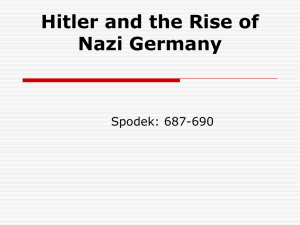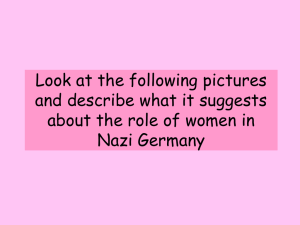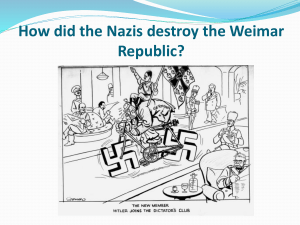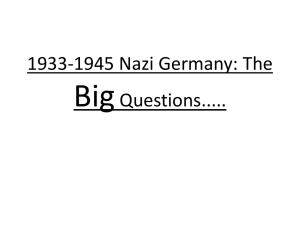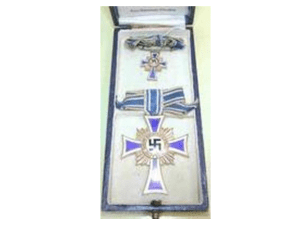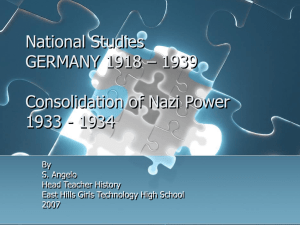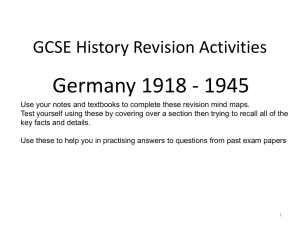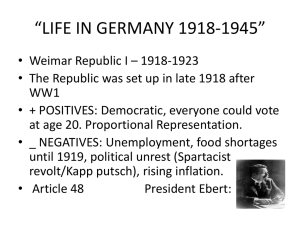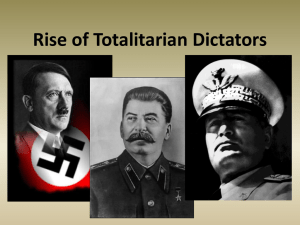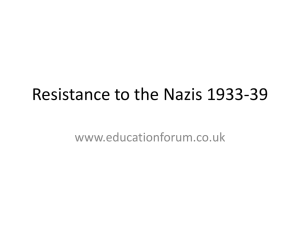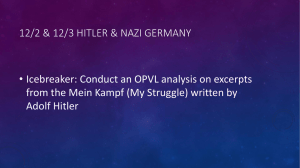GERMANY_files/Nazi Consolidation of Power rev
advertisement
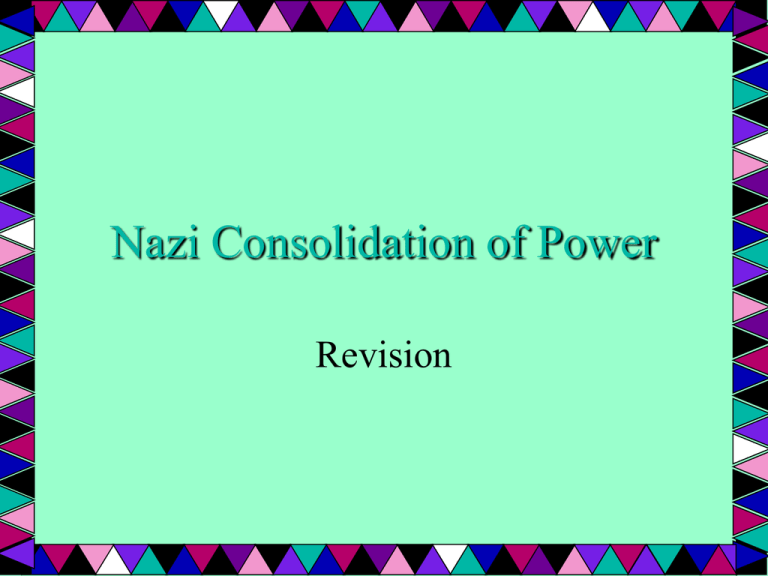
Nazi Consolidation of Power Revision How did Hitler consolidate his position as leader of Germany? EIGHT STEPS TO DICTATOR • • • • • • • • Reichstag Fire – 27th February 1933 General Election - 5th March 1933 Enabling Act – 23rd March 1933 Set up Gestapo – April 1933 Banned Trade Unions – 2nd may 1933 Banned Opposition – 14th July 1933 Night of the Long Knives – 30th June 1934 Fuhrer – 19th August 1934 How did Hitler strengthen his control over Germany? • REICHSTAG FIRE – When the Reichstag burned down a communist named Van der Lubbe was caught with fire-lighting materials. Hitler used this as an excuse to arrest many of his communist opponents, and as a major political platform for his election campaign. The day after the fire Hindenburg passed the decree for the PROTECTION OF THE PEOPLE AND THE STATE. This gave the government sweeping powers to suspend civil liberties and freedoms. • MARCH ELECTIONS – Hitler held an election appealing to Germans to give him a a clear majority. Only 44% voted Nazi so Hitler arrested 81 Communist deputies, and he struck a deal with the Centre Party - thus giving him a majority in the Reichstag. • ENABLING ACT – This gave Hitler the power to make his own laws, without parliamentary power for 4 years. Hitler used this act to get rid of anyone or anything that limited his power, The Act made Hitler dictator of Germany, with the power to do anything he desire – LEGALLY. • SET UP GESTAPO – Nazis took over local government and police. Started to replace anti-Nazi teacher/professors. Hitler set up the Gestapo and encouraged Germans to report opponents. Thousands of opponents were arrested and sent to concentration camps. • BANNED TRADE UNIONS – Trade Unions were closed, their money confiscated, and leaders put in prison. GERMAN LABOUR FRONT set up which reduced wages and took away the right to strike. • BANNED OPPOSITION – THE LAW AGAINST THE FORMATION OF PARTIES was passed, declaring the Nazis as the only political party. (One – party state) Leaders of other political parties were imprisoned. • NIGHT OF THE LONG KNIVES – The SA were thugs who had helped Hitler to come to power by attacking opponents and defending his meetings. By 1934 there were more than a million of them and they were becoming an embarrassment to Hitler. Their leader Rohm was a threat to Hitler due to his talk of a “Brown revolution”. On the night of 30th June 1934 the SS were ordered to kill more than 400 SA men. • FUHRER- When Hindenburg died Hitler combined the role of Chancellor and President. He also became head of the army with all officers swearing an oath of allegiance to him. Why and how did the lives of Jews change in Germany between 1933 and 1939? • Why – He had an obsessive hatred of Jews and anti-semitism soon became government policy. • How – 1933 Boycott of Jewish shops and businesses. 1935 Nuremburg laws – isolated Jews from the rest of society. Jews became subjects of the state and intermarrying between Jews and Germans was forbidden. 1937 Persecution continued and increased. 1938 November – Kristallnacht – Attacks on Jewish owned businesses, Over 100 Jews killed and 20,000 sent to concentration camps. 1939 Jews banned from German schools and were confined to their own districts. Not allowed to visit restaurants or cinemas. The Nazis were preparing to remove all traces of Jews from Germany. How did the lives of women change? • Nazis saw the part that women had to play as different but equally important to men. • Kinder, Kuche, Kirche • Women were encouraged to stay at home and take courses on motherhood • The Nazis glorified the ‘mother image’; woemn who had more than 4,6, or 8 children were awarded The Mother’s Cross • Abortion was made illegal • Lebensborn homes were set up to encourage unmarried women to have children with racially pure SS men • Women were banned from top professional jobs • Goebbels said “The mission of women is to be beautiful and bring children into the world”. Young People: Youth Movements • The Nazis believed that to control Germany’s future they had to influence the minds of young people through youth movements and schools. • Main purpose of movements was to indoctrinate young people with important Nazi ideas. • After 1933 all young people were encouraged to join Youth movements; they were separate ones for boys and girls. • Boys = military activities/girls = motherhood. • 1936 – Hitler Youth Law – membership was compulsory, and after 1939 all members had to swear an oath of loyalty to the Fuhrer. Young People: Schools • Schools were used to control the minds of young people. • Many changes were made to the curriculum – German. History, Biology and PE were most important. • German language & literature = highlighted German military successes • Biology = Importance of race/Inferior races • PE = Perfect Aryan was physically fit • All textbooks were approved by the government • Jewish teachers were sacked and Jewish children were not allowed to attend German schools • Teachers had to attend training camps to help them teach the Nazi curriculum • Elite schools were set up to train future leaders • Schools promoted loyalty and obedience. How did the Nazis deal with churches in Germany between 1933 and 1939? • Initially the Nazis made no effort to interfere with the churches • In 1933 the Nazis signed the Concordat with the RCC – it was allowed to keep its schools and youth groups as long as it did not interfere with the Nazi party. • By 1937 most of these concessions had been removed. • Within the Protestant faith there were those who opposed and supported the Nazis. • SUPPORTED – German Christians led by Muller • OPPOSED – Confessional Church led by Niemoller – He was arrested and sent to a concentration camp in 1937. • Nazis also tried to set up their own church – GERMAN FAITH MOVEMENT – Only 5% of Germans registered as supporters • The Nazis never destroyed the established churches in Germany. They made it difficult for people to worship but churches remained open. Hitler did weaken the churches as a source of resistance to his policies. How did the lives of workers change under the Nazis? • Workers had to work longer hours • Workers could not leave their places of employment without permission • Trade Unions were abolished. All workers had to join the DAF • Women were sacked from professional jobs • Set up the KDF (Strength through Joy) to control worker’s leisure time • Beauty of labour improved conditions in factories and canteens • Unemployed were forced to join the RAD (public work schemes) and the army How did the Nazis use propaganda to control Germany? • Education and indoctrination of young people – changes in curriculum/textbooks and burning of books • Radio was controlled by the Nazis – People’s Receiver. Loudspeakers in public area’s broadcasting Hitler’s speeches • Nazis controlled newspapers – strict censorship – Editor’s Law. Non-Nazi newspapers closed down • Mass demonstrations and rallies – Nuremburg Laws. Showed discipline and order • Cinema – showed Nazi propaganda films/newsreels at the beginning of each show • Posters – Portrayed Hitler as Germany’s saviour
